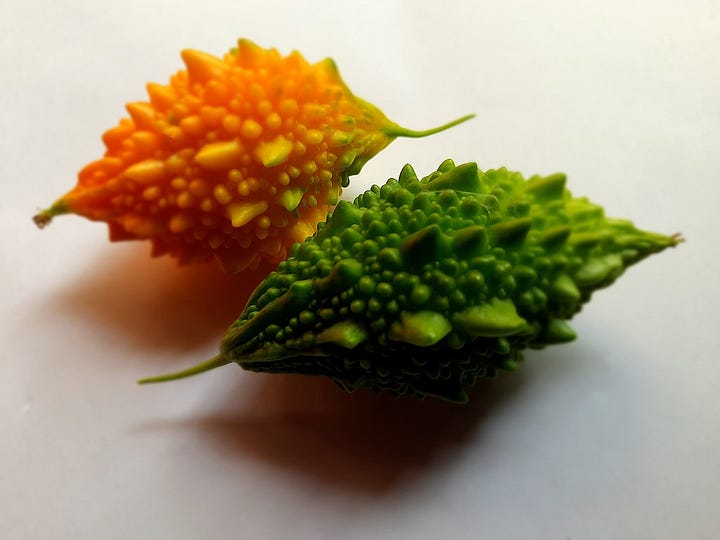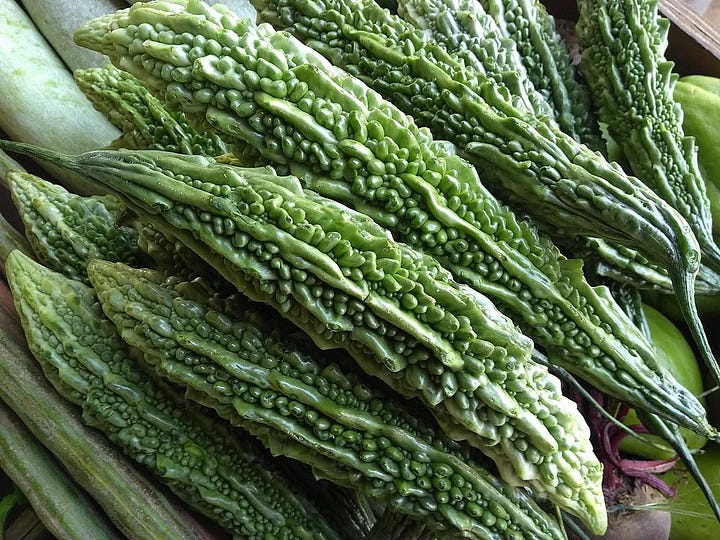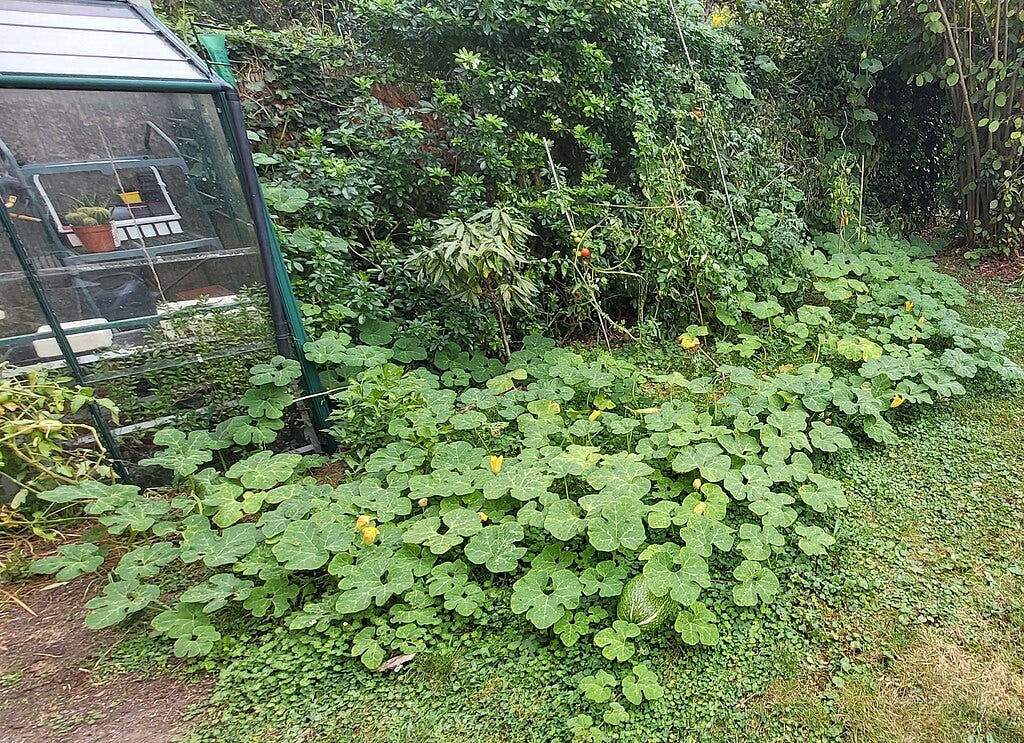“I don’t like it, it’s too bitter.”
My daughter, trying my home grown cucumbers.
Sometimes, a single sentence can plant a literal seed in your mind that slowly takes root, probing your dreams and thoughts until it taps into a rich seam of creative juice and leaps forth - a beautiful idea that has been slowly growing in your hind brain.
What if I could grow Bitter Melons (Momordica charantia) outside in a typical cloudy and cold British summer?


Why would I even want to do that? Who the heck wants to eat a vegetable that is primarily bitter?
Well, I do, for one.
Also known as Bitter Gourd, goya, and many other names, Momordica charantia is a knobbly melon borne on tendrils and cultivated as a vegetable all over Asia, Africa and the Caribbean.
In India, it is served alongside a dish of yogurt to minimise the bitterness, added straight to curries or stuffed with spices and fried, pickled, boiled and mashed with salt, and on and on.
The Thai like to stuff it with pork before boiling it in a clear broth.
Filipinos like to stir fry it with eggs.
The Vietnamese eat Bitter Gourd as raw slices (brave!).
Look up the recipes yourself, there are so many!
For myself, I’ve eaten bitter melon slices fried with meat (generally beef) a few times in my life, and have been seeking this unique combination of flavours ever since. I like to pick up a few frozen bitter melons if I ever stray near an Oriental supermarket.

Unfortunately for me, Bitter Melon prefer hotter climates than I can reasonably provide. They’re similar to tomatoes in that respect. In their native climates they are perennials, but in places like the UK we are reduced to growing them from seed every year.
Bitter Melon, unlike tomatoes, has not seen a whole army's worth of dedicated breeding to explore the manifold genetic adaptations to colder climates. From what I’ve noticed, breeders of tomatoes for colder climes focus on quick and early ripening rather than cold resistance. You can see this type of heroic breeding pressure with cucumbers too, which also prefer warmer conditions than I can provide.
I bring up cucumbers because they, like Bitter Melons, belong to the Cucurbitaceae family. Also known as the cucurbit, or gourd family, this group of plants has many famous members including watermelon, cucumber and pumpkin.
I guess I should not be perplexed by the lack of cold adapted, early ripening Bitter Melon. The modern Western food palette has very little room for bitterness. Possibly the only consistent source of bitterness is some store bought leafy salad but I don’t count those because they tend to be smothered to oblivion with sauces.
In general, bitterness is associated with poison. There are a few well publicised bitter compounds like cyanide or strychnine.
Strychnine was historically used as a sport performance enhancer at low doses and at higher doses a pesticide. The incredibly painful muscular cramps that lead to a dramatic arching of the back mean it is often used by in popular literature of bygone times as a murder weapon.
Not all that is bitter is poison though, and we risk dooming ourselves to a duller cuisine and poorer health if we perpetuate this deathly coupling.
Dandelion leaves are a famously bitter foraged salad and a quick search online will show you countless questions on how to reduce this bitterness. Sesquiterpenes are responsible for their bitterness, and in modest amounts have been shown to have anti-inflammatory, cardiovascular, gastro-protective, and anticancer properties.
For the case of Bitter Melons and cucurbits in general, cucurbitacins are responsible for their bitterness. In other domestic cucurbits these compounds have been generally bred to a low level (unless you’re my daughter with amazingly sensitive bitter sensing taste buds). Bitter Melons have a unique sub-group of cucurbitacins called the Momordicosides which are generally safe (even good for you) and not retained in the body unless consumed at nonsensical quantities.
So, call me a Momordicoside connoisseur or whatever (I do also really enjoy the texture of Bitter Melon), my quest is to breed a cold summer adapted bitter melon.
As with cold temperate adapted tomatoes and cucumbers I will probably be seeking early ripening as a primary growing trait but also willingness to germinate in colder soil temperatures.
I plan to go down two different routes with this project.
In my allotment greenhouse I plan to direct sow a grex (varied cultivar seed mixture) of Bitter Melons from different countries. As I can’t visit the allotment very often, I will also end up selecting for robustness. I’ll take the earliest ripening bitter melons and sow some directly outside and some inside the greenhouse again and repeat until I score some that can reliably direct seed outside.
The second method will be more ambitious, utilising mentor grafting (see my Franken-plant series). I did some research and found the most cold adapted and vigorous-to-the UK cucurbit out there called Cucurbita ficifolia. I’ve seen this plant growing in the Great British outdoors and can confirm that it is indeed very vigorous. This cucurbit is also known as Shark Fin melon (the texture is analogous to shark fin and used by Chinese people as a friendly substitute to shark fin soup).
Shark Fin melon is a fascinating cucurbit of murky origin, grown and enjoyed all over the world. Every so often people attempt crosses with other members of the Cucurbit species and have noticed that the offspring tend to be sterile.

I aim to germinate some Shark Fin melon alongside bitter melon and plug graft - yes, almost literally sticking a hole in one plant and plugging in another plant - in a sapling bitter melon plant.
The idea is that the genetic material of the Shark Fin melon is forced into the bitter melon sapling, granting it some of the vigorous qualities of the shark fin melon. Some of these genes will be expressed in the seeds of the grafted shark fin melon, which will then be grown out. If we repeat this process several times, each time using some of these Franken seedlings, we should get a bitter melon that increasingly resembles the shark fin melon. Hopefully, the resemblances go deeper than skin and we end up with a reliably direct sown bitter melon Franken-plant.
Will anyone even want my cold summer adapted Bitter Melons? I’m sure there’s an audience out there.
Perhaps I’ve persuaded you that bitter stuff can be good for you, and you can grow to prize Bitter Melon as a delicacy as I do. Maybe I can count you, dear reader, as a new fan.
One thing is for sure, my daughter won’t like any of the cucurbits I grow this year!
Final Thoughts
There’s a whole technique and art to mentor grafting of which I am just an apprentice and I intend to document my process as I go along. One of the important parts is to trim off any leaves from the Shark Fin melon to make sure that the maximum amount of sap flows into the grafted bitter melon.
Do you feel like the odd one out for liking bitter vegetables? Drop a comment below and we can commiserate together.
Until next time.
Further Reading
Cucurbitacin B and cancer intervention: Chemistry, biology and mechanisms (Review)
Cucurbitacin: Ancient Compound Shedding New Light on Cancer Treatment
Facts About Strychnine
Sesquiterpenes in Fresh Food
Population Genomics of Domesticated Cucurbita ficifolia Reveals a Recent Bottleneck and Low Gene Flow with Wild Relatives
Plant grafting: new mechanisms, evolutionary implications
My first forays into the world of mentor grafting
Some references to Momordicoside




Understood. I’m now wondering whether I should also try this experiment. It seems such a good idea…
How did this experiment turn out? I’d love to be able to grow these here in the UK.